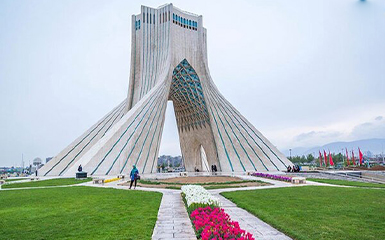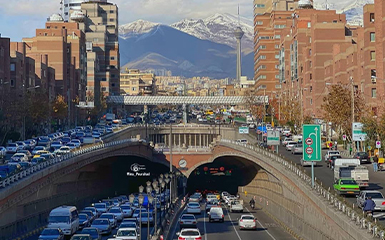Ardabil
Arg-e Bam
Abyaneh
Babak Castle
Behistun
Chogha Zanbil
Dasht-e Lut
Golestan Palace
Isfahan
Imam mosque
Kashan
Kharanaq
Mashhad
Masuleh
Meymand
Pasargadae
Naqsh-e jahan
Naqsh-e Rostam
Persepolis
Rayen Citadel
Saint Thaddeus
Saint Stepanos
Shiraz
Shushtar
Sultan Amir Ahmad
Tabriz
Takht-e Soleyman
Tehran
Tower of Silence
Yazd
Tehran

Located on a vast glacis in the south of Alborz, the city is separated from the nearby desert by the rich agricultural plains of Karaj, Rey and Varamin. The bio-geographical differences between the north of the city is cool, wooded, rich in water resources, a summer vacation spot, and the south is very hot in summer, close to the desert, where the bazaar and the historic city are located, have structured the history and the social hierarchy of the capital. The social level went hand in hand with the access to abundant and clean water resources, therefore with the proximity of the mountain.
Tehran developed after the Mongols razed the very old city of Rey in 1220. The Arab traveller Yaqut reports for the first time in 1224 an area of settlement bearing this name, in the middle of gardens, some distance north of the ancient destroyed city. The development of the city is explained by this proximity, then by the presence of the Shiite sanctuary of Shah Abd ol-Azim and, above all, by the fact that the Iranian sovereigns spent the summer and hunted in the valleys of the Alborz centre almost continuously from the 13th to the 20th century. It was while seeking to meet Tamerlane in the Lar valley that the Spanish traveller Clavijo stayed in 1404 in the “city” (ciudad) of Tehran. In 1786, Agha Mohammad Khan Qajar seized this town near the summer pastures of his tribe and had himself crowned there. For the Qajars, Turkic-speaking nomads, the notion of capital did not exist, but Tehran became the winter residence most frequented by the dynasty. British, French, Russian and Turkish foreign diplomatic missions began to settle there.
Tehran is a cosmopolitan city, with great museums, parks, restaurants, warm and friendly people. It deserves at least a few days of your Iranian itinerary. The northern districts of Tehran are more prosperous, modern, cosmopolitan and expensive, while the southern regions are less attractive, but less expensive.
Tehran has also earned itself the unenviable reputation as a smog-filled, traffic-choked and featureless sprawl of jam-packed concrete with 14 million inhabitants. However, you can also find an endless number of friendly and cosy places in and around the city - if you know where to look. Tehran is also a city of parks and has more than 800 of them, all well maintained. The city is nearly a mile high from the sea and as a result is colder than other cities in the Middle East. The air tends to be very dry.
The Alborz range north of Tehran, home to the highest peak in Iran, offers fantastic conditions for winter skiing enthusiasts. In winter, the mountain hotels and ski clubs in Shemshak, and Dizine are full several days a week. Some specialized skiers consider the value of the snow in northern Tehran to be one of excellent in the world.

